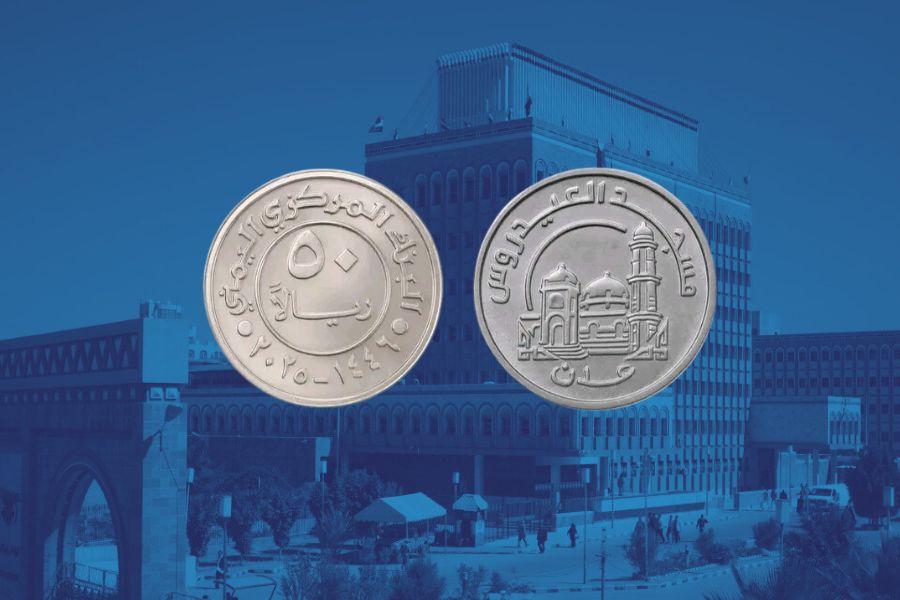
An image of the new coin superimposed with the Central Bank of Yemen building in Sanaa (South24 Center)
13-07-2025 الساعة 7 مساءً بتوقيت عدن
|
|
Sanaa (South24 Center)
The Central Bank in Sanaa, under Houthi control, announced on Saturday, July 12, the issuance of a new 50-Yemeni rial coin, confirming that its circulation in local markets would begin on Sunday, July 13.
In an official statement, the bank said that the issuance comes as part of measures to address the currency deterioration and improve the quality of circulating cash, and asserted that the move will not increase money supply or affect exchange rates.
This marks the bank's first issuance of currency since March 2024, when it introduced a 100-rial coin -- a step rejected by the Yemeni legitimate government as an illegal measure that would exacerbate monetary division in the country. At that time, the U.S. and European embassies condemned the move, with international organizations warning of its economic consequences.
The new decision comes amid UN warnings against unilateral monetary policy steps that could undermine the economic understanding brokered by UN envoy Hans Grundberg in July 2024, which aimed to prevent monetary escalation between the central banks in Sanaa and Aden.
In a strong statement issued on Sunday, July 13, the Central Bank of Yemen in Aden condemned the new coin as a “counterfeit currency” and accused the Houthis of continuing an “economic war” against the Yemeni people.
The bank described the move as a “reckless and destructive act” by an “illegitimate entity” and warned all businesses, banks, exchange companies, and citizens in Houthi-controlled areas against using or accepting the new coin or any previously issued unauthorized currency, warning of potential international sanctions.
The Aden-based bank emphasized that this “dangerous escalation” violates the UN-brokered agreement of July 23, 2024, and undermines regional and international efforts to unify monetary policy. It accused the Houthis of failing to comply with any terms of the agreement while continuing to harass banks, airlines, and economic institutions under their control.
The statement further urged international stakeholders to condemn the move and hold the Houthis accountable for its consequences, pledging that the Aden-based Central Bank will exercise its constitutional and legal right to protect the national currency and public financial interests.
In June 2024, the monetary crisis between the Aden-based Central Bank and the Sanaa-based Central Bank escalated when the Aden bank decided on June 23 to tighten oversight on foreign transfers through the SWIFT system, demanding that Yemeni banks either relocate to Aden or cease operations and began blacklisting six banks operating from Sanaa after the expiration of the specified deadline.
In response to this move, the Houthi-controlled Central Bank in Sanaa suspended dealings with 13 banks operating from Aden and disrupted dollar transfers between the South and North.
In July 2024, after nearly a month of escalation, UN envoy Hans Grundberg intervened to calm the situation, calling for a freeze on punitive measures and the start of dialogue between the two sides. On July 23, a joint agreement was officially announced to cancel banking-related sanctions, stop any new punitive steps, and resume Yemenia flights between Sanaa and Oman, marking a new phase of economic de-escalation.
For years, the gap in the value of the Yemeni rial between Aden and Sanaa has unprecedentedly widened, creating two different currencies within the country. In areas under the internationally recognized government (primarily the South), the dollar exchange rate has risen from about 2,735 rials for purchase in early July to approximately 2,838-2,861 rials on July 12.
In Sanaa, the rial remains almost fixed at 533-535 for purchase and 535-536 for sale against the U.S. dollar.
The Yemeni government says that Sanaa's exchange rates are fictitious, noting that they do not reflect the reality of citizens’ purchasing power or living burdens in the local market, but rather represent arbitrary policies to project a false image of stability for the Sanaa Central Bank.
With the Houthi side introducing a new coin and the Aden-based bank issuing a sharp rejection, Yemen’s monetary divide appears set to deepen further — threatening what little economic stability remains and putting UN-brokered efforts at serious risk.